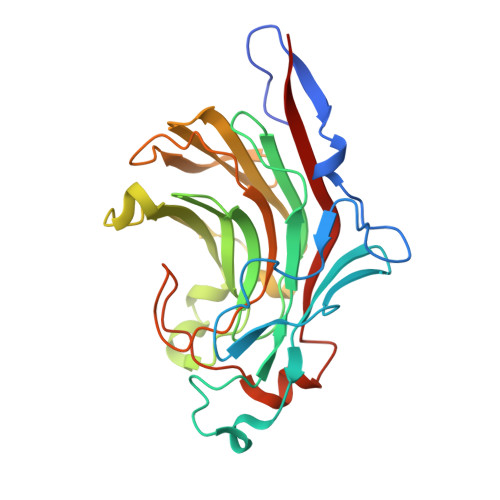Biochemical and Structural Characterization of the Complex Agarolytic Enzyme System from the Marine Bacterium Zobellia Galactanivorans.
Hehemann, J.H., Correc, G., Thomas, F., Bernard, T., Barbeyron, T., Jam, M., Helbert, W., Michel, G., Czjzek, M.(2012) J Biological Chem 287: 30571
- PubMed: 22778272
- DOI: https://doi.org/10.1074/jbc.M112.377184
- Primary Citation of Related Structures:
4ASM, 4ATE, 4ATF - PubMed Abstract:
Zobellia galactanivorans is an emerging model bacterium for the bioconversion of algal biomass. Notably, this marine Bacteroidetes possesses a complex agarolytic system comprising four β-agarases and five β-porphyranases, all belonging to the glycoside hydrolase family 16. Although β-agarases are specific for the neutral agarobiose moieties, the recently discovered β-porphyranases degrade the sulfated polymers found in various quantities in natural agars. Here, we report the biochemical and structural comparison of five β-porphyranases and β-agarases from Z. galactanivorans. The respective degradation patterns of two β-porphyranases and three β-agarases are analyzed by their action on defined hybrid oligosaccharides. In light of the high resolution crystal structures, the biochemical results allowed a detailed mapping of substrate specificities along the active site groove of the enzymes. Although PorA displays a strict requirement for C6-sulfate in the -2- and +1-binding subsites, PorB tolerates the presence of 3-6-anhydro-l-galactose in subsite -2. Both enzymes do not accept methylation of the galactose unit in the -1 subsite. The β-agarase AgaD requires at least four consecutive agarose units (DP8) and is highly intolerant to modifications, whereas for AgaB oligosaccharides containing C6-sulfate groups at the -4, +1, and +3 positions are still degraded. Together with a transcriptional analysis of the expression of these enzymes, the structural and biochemical results allow proposition of a model scheme for the agarolytic system of Z. galactanivorans.
- Université Pierre et Marie Curie, Végétaux Marins et Biomolécules UMR 7139, Station Biologique de Roscoff, F 29682 Roscoff, France.
Organizational Affiliation:



















